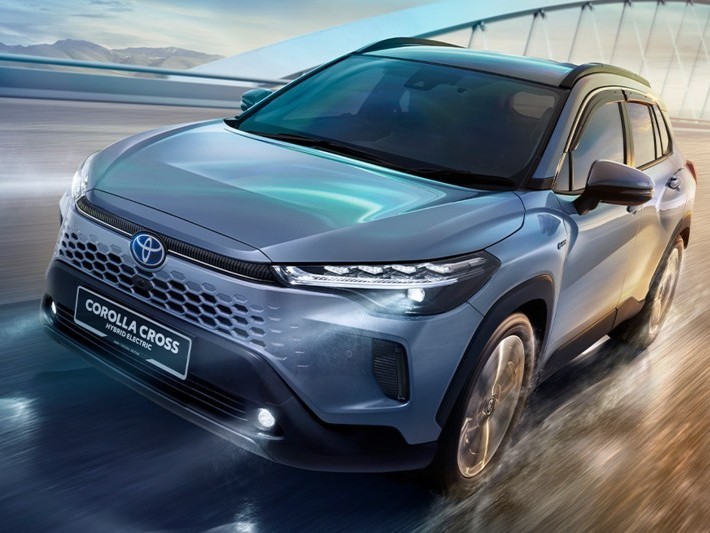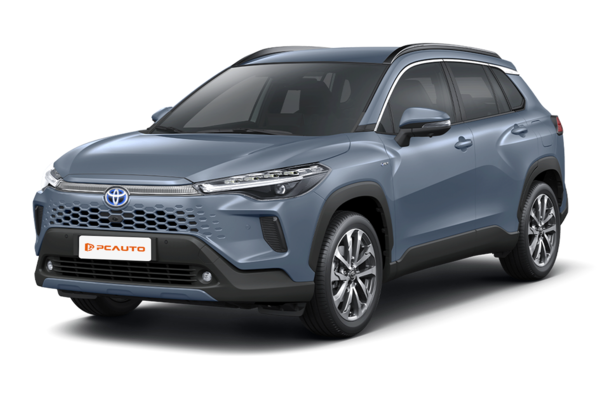Q
how much is the new toyota corolla cross
The all-new Toyota Corolla Cross in Malaysia comes with varying price tags depending on the trim and specs. The base 1.8G starts at around RM130,400, while the hybrid 1.8V Hybrid kicks off from RM142,000. Keep in mind, these prices might shift a bit with regional promotions or added options. Under the hood, you've got the choice of a 1.8L naturally aspirated engine or a 1.8L hybrid setup. Toyota Safety Sense comes standard across the range, packing features like pre-collision warning and lane-keeping assist – making it a solid value proposition in the competitive C-SUV segment.
For Malaysian buyers, the Corolla Cross hits sweet spots with Toyota's reputation for reliability, relatively low maintenance costs, and a practical 161mm ground clearance that handles local roads well. The hybrid variant, in particular, delivers better fuel efficiency, which is a big plus for those regularly stuck in city traffic.
If your budget is tighter, you might want to check out rivals like the Honda HR-V or Mazda CX-30. Just remember, different brands offer varying after-sales support and warranty terms. My advice? Always schedule a test drive to compare handling and interior space before making your decision.
Special Disclaimer: This content is published by users and does not represent the views or position of PCauto.
Related Q&A
Q
What is the wheelbase of the Toyota Corolla cross?
The Toyota Corolla Cross has a wheelbase of 2,640mm, which is slightly above average for its class of SUVs. This gives it a relatively spacious rear legroom while still keeping things nimble enough for city driving. Since wheelbase is one of the key factors in determining cabin space, it directly impacts passenger comfort and boot capacity—making the Corolla Cross a practical choice for daily family use or longer trips.
That said, vehicles with longer wheelbases tend to feel more stable at higher speeds but can have a slightly wider turning radius. Toyota’s engineers have tuned the chassis to strike a balance between these two traits. Built on the TNGA platform, the Corolla Cross also benefits from improved body rigidity and smarter space utilization, so that 2,640mm wheelbase works harder than the number might suggest.
Just keep in mind that wheelbase alone doesn’t tell the whole story—ground clearance, overall width, and even how efficiently a brand uses its wheelbase can affect real-world space. If you’re comparing options, a test drive is still the best way to judge.
Q
Is the 2023 Corolla Cross a good car?
The 2023 Corolla Cross is a well-rounded compact SUV that ticks all the right boxes for daily family use, backed by Toyota's reputation for reliability and practical design. It offers either a 1.8L naturally aspirated engine or a hybrid powertrain—both deliver solid fuel efficiency, with the hybrid notably cutting city driving costs while keeping maintenance affordable.
Inside, you’ll find flexible cabin space and a trunk that handles family trips with ease. Standard Toyota Safety Sense packs features like pre-collision alerts and lane-keeping assist, adding peace of mind on the road. The interior keeps things functional, with a 9-inch touchscreen supporting Apple CarPlay/Android Auto—right in line with what most buyers expect.
That said, don’t expect thrilling acceleration; the power delivery leans smooth rather than punchy, making it better suited for relaxed commutes. On the resale front, Toyotas generally hold their value well, but it’s worth cross-shopping rivals in this price range. Take it for a test drive to see if the suspension tuning and cabin noise levels match your preferences, and always double-check the dealer’s warranty fine print before signing.
Q
What is the safety rating of the Toyota Corolla 2021?
The 2021 Toyota Corolla excels in safety performance and has earned recognition from several international authoritative bodies. For instance, it achieved a five-star rating in Euro NCAP testing and was named a "Top Safety Pick" in IIHS crash tests in the United States. This model comes standard with the Toyota Safety Sense 2.0 active safety system, which includes features like a pre-collision system, lane departure alert, adaptive cruise control, and automatic high beams, providing comprehensive safety protection for drivers. In addition, the Corolla's body structure uses high-strength steel, effectively enhancing its impact resistance, and it is equipped with multiple airbags to further ensure passenger safety. For consumers considering purchasing this car, its safety performance is an important plus. Similar safety configurations in competing models are gradually becoming industry standards, indicating that automakers are placing increasing importance on safety performance. Consumers can pay more attention to these details when choosing a vehicle to ensure the driving safety of themselves and their families.
Q
Is the 2021 Corolla a good first car?
The 2021 Corolla makes a solid first car. It’s reliable, gets good gas mileage, and is super easy for new drivers to handle. Under the hood, you’ve got either a 1.8L or 2.0L naturally aspirated engine—smooth and built to last—paired with a CVT transmission that makes daily commuting a breeze while keeping fuel costs down. It also comes standard with Toyota Safety Sense, which includes pre-collision warning, lane keep assist, and adaptive cruise control—all stuff that really helps boost safety on the road. The interior is simple and functional, with decent space that works well for small families or singles. Maintenance costs are pretty reasonable too, and parts are easy to find, so owning it long-term is low-stress. If you want a bit more pep, the 2.0L version has quicker acceleration. It holds its value better than most in its class too, so you won’t take as big a hit when it’s time to trade up. Compared to other compact cars out there, it’s just really well-rounded—no major weaknesses. All in all, it’s a really safe bet for an entry-level ride.
Q
What kind of engine does the 2021 Corolla have?
The 2021 Corolla offers a range of engine options depending on the trim and configuration. The most common ones are the 1.8-liter and 2.0-liter four-cylinder naturally aspirated engines. The 1.8L puts out 139 horsepower, paired with a CVT transmission, and it's all about being economical and practical—perfect for daily commuting. Then there's the 2.0L, which cranks out 169 horsepower, delivering better performance for folks who want a more engaging driving experience. Some markets also get a 1.8L hybrid version that combines a gas engine with an electric motor for even better fuel economy.
Tech-wise, all these engines feature Dual VVT-i variable valve timing, which helps optimize fuel efficiency and power delivery. They're also known for being pretty reliable and durable, with relatively low maintenance costs. If you're thinking about buying a Corolla, pick the powertrain that fits your budget and needs. The 1.8L is great if saving gas is your top priority, the 2.0L suits drivers after more zip, and the hybrid can cut down on fuel costs even more over the long haul.
Q
What is the maintenance on a 2021 Toyota Corolla?
The regular maintenance for the 2021 Toyota Corolla mainly involves changing the engine oil and oil filter every 10,000 kilometers or 6 months, whichever comes first—this is the foundation for ensuring the engine runs smoothly over the long haul. The air filter should be inspected or replaced every 20,000 kilometers, and the cabin air filter is recommended to be changed annually or every 20,000 kilometers to keep the interior air quality fresh. Brake fluid needs replacing every 40,000 kilometers or 2 years. For CVT models, the transmission fluid should be checked every 80,000 kilometers and replaced if necessary, while spark plugs typically need swapping out at 100,000 kilometers. Also, regularly checking tire pressure, brake pad thickness, and the tightness of chassis bolts is crucial—these little details boost driving safety and cut down on long-term repair costs. It’s worth noting that as a globally best-selling model, the Corolla has relatively affordable maintenance costs, with plenty of original parts available and many third-party repair shops familiar with its structure, so owners can choose between original factory service or reputable third-party options based on their budget. If you want to further extend the vehicle’s lifespan, it’s advisable to get a comprehensive inspection every 50,000 kilometers, including the suspension system and drivetrain components. This helps spot potential issues early and avoids bigger losses down the line.
Q
How much is insurance on a 2021 Toyota Corolla?
The insurance cost for a 2021 Toyota Corolla typically ranges from RM1,500 to RM3,500 per year. The exact amount depends on factors such as the vehicle model, engine displacement, type of insurance coverage, and the owner's personal circumstances. Comprehensive insurance premiums are higher than third-party insurance. Key factors affecting premiums include the owner's age, driving record, vehicle usage location, and selected insurance add-ons. For example, younger owners or those living in accident-prone areas may need to pay higher premiums. To get a more accurate quote, it is recommended to enter specific information on the insurance company's official website or through an agency platform for calculation, and also compare the preferential schemes of different insurance companies. In addition, it is important to understand the deductible and claim scope in the insurance terms, as these details directly affect the actual compensation amount when making a claim. Regularly reviewing the insurance policy and adjusting the insured amount according to vehicle depreciation can help owners control insurance costs more reasonably in long-term use.
Q
How much does a battery cost for a 2021 Toyota Corolla?
The battery price for a 2021 Toyota Corolla typically ranges from RM500 to RM1000, depending on the battery type and brand. Original equipment (OE) batteries are more expensive but come with a longer warranty, while third-party brands like Amaron or Bosch offer better value for money with shorter warranties. It's recommended to choose a maintenance-free battery (MF battery) that meets the vehicle's specifications. These batteries don't require regular water refills and have a longer lifespan, usually 2 to 3 years. When replacing the battery, pay attention to specifications such as capacity (Ah) and cold cranking amps (CCA) to ensure compatibility with the vehicle's electrical system. Additionally, regularly checking the cleanliness and tightness of battery terminals helps extend battery life. If the vehicle is parked for an extended period, it's advisable to start it once a week to maintain battery charge. Choosing a reputable repair shop or authorized service center for battery replacement ensures quality installation and access to professional testing services.
Q
How long does a 2021 Corolla battery last?
The battery life of a 2021 Corolla typically ranges from 3 to 5 years, depending on usage habits and maintenance. If you often take short trips or leave it parked for long periods, the battery will wear out faster. Regularly checking the electrolyte level and keeping the terminals clean helps extend its life. Climate is also a big factor—hot weather speeds up battery aging, so it’s advisable to get a professional check every two years. Besides the original factory battery, there are plenty of high-performance alternatives on the market, like maintenance-free or AGM batteries, which are better suited for vehicles with frequent start-stop systems or added car electronics. In daily use, turning off the air conditioning and lights before shutting off the engine reduces battery strain. If you notice slow starting or the battery warning light on the dashboard comes on, have it checked promptly to avoid getting stranded. Most repair shops offer free battery testing services, making it easy for owners to stay on top of its condition.
Q
How long should a 2021 Toyota Corolla last?
The 2021 Toyota Corolla can typically hit 200,000 to 300,000 kilometers or more with regular maintenance and normal use. Its durability mainly comes down to Toyota's tried-and-true powertrain and solid manufacturing. The 1.8L or 2.0L naturally aspirated engines and CVT transmissions in this model have been market-tested for ages—keep up with regular oil changes, transmission fluid swaps, and other routine maintenance as per the manual, and those mechanical parts will hang in there a lot longer.
Day-to-day, pay extra attention to the cooling and ignition systems. If you're in a hot climate, shorten the coolant replacement interval, and if you mostly do short trips, keep an eye on the battery. For rust protection, the factory does a basic job, but coastal owners might want to add a chassis undercoat. Worth noting: the hybrid version, with its reduced engine load, could theoretically have an even longer-lasting powertrain.
At the end of the day, how long the car lasts depends a lot on how you drive and take care of it. Aggressive driving or constant overloading will wear things out faster, but smooth driving and sticking to the maintenance schedule will maximize its lifespan. On the used car market, Corollas with complete service records usually hold their value well—another sign of their long-term reliability.
Popular Cars
Model Year
Car Compare
Car Photo
Latest Q&A
Q
Is the 1.5 L 4 cylinder?
Yes, a 1.5L engine is typically a 4-cylinder setup—the most common configuration for small to mid-sized displacements. This layout strikes a solid balance between fuel efficiency and power output, making it ideal for daily commuting and family use. Four-cylinder engines are relatively simple in design, cheaper to maintain, and benefit from proven technology that delivers smooth operation. You'll find this configuration widely used by mainstream brands like Honda, Toyota, and Mazda. While there are some 1.5L 3-cylinder options out there, the 4-cylinder remains the go-to choice, especially in models prioritizing durability and refinement. If you're shopping for a 1.5L-powered car, pay attention to specific tech features—turbocharging, direct injection, etc.—as these can significantly impact real-world driving dynamics and fuel economy.
Q
What is the displacement of a V8 engine?
The displacement of a V8 engine typically ranges from 4.0 to 6.2 liters, depending on the vehicle and its purpose. For example, high-performance sports cars often pack a 5.0-liter or larger V8, while trucks and SUVs usually stick with something between 4.3 and 5.7 liters. Known for its brute power and smooth operation, the V8 is a go-to for acceleration and towing—though its thirst for fuel is something buyers always weigh up.
These days, turbocharging has changed the game. Smaller-displacement V8s (like a twin-turbo 4.0L) can now deliver big-block performance with slightly better efficiency. And let’s not forget the sound—few things beat the roar of a tuned V8 exhaust, a big reason why enthusiasts love ‘em.
If you’re into V8s, keep an eye on local used car listings or auto shows—you’ll often spot some gems there.
Q
What is the difference between 1l and 1.2 L engine?
The key difference between 1-liter (1L) and 1.2-liter (1.2L) engines comes down to displacement—the total volume of all cylinders in an engine, measured in liters. Generally, a larger displacement means more power and torque, so a 1.2L engine will likely feel stronger during acceleration, highway driving, or when tackling hills with a load. That said, it’ll also drink a bit more fuel compared to the 1L.
The 1L, being smaller, prioritizes fuel efficiency, making it a smart pick for city commuting or everyday runs. On the flip side, the 1.2L’s extra performance often means higher manufacturing costs, which might bump up the car’s price tag. Plus, the 1L’s compact size fits better in smaller or budget-friendly models.
Your choice really hinges on driving needs: go for the 1.2L if you regularly hit the highway or want more grunt, but stick with the 1L if you’re mostly urban-bound and watching fuel bills. Oh, and don’t forget—tech like turbocharging or variable valve timing can squeeze near-equal performance from smaller engines these days, so specs alone don’t tell the full story. Always check how the engine’s tuned.
Q
What does 5.7 liter engine mean?
A 5.7-liter engine refers to a total displacement of 5.7 liters, meaning all cylinders combine for a total working volume of 5,700 cubic centimeters. Generally, a larger displacement allows the engine to take in more air and fuel, delivering stronger power and torque—making it ideal for performance-oriented vehicles or those built for heavy-duty work, like pickup trucks, full-size SUVs, or muscle cars.
In the local market, you’ll often find big-displacement engines in American-branded vehicles. These engines excel at high-speed cruising or towing heavy loads, though they do come with higher fuel consumption and increased running costs.
Thanks to advancing technology, many automakers now use turbocharging or hybrid systems to help smaller engines deliver power comparable to older, larger naturally aspirated units—like how some modern 2.0L turbocharged engines can match the performance of older V6 engines while being far more fuel-efficient.
If fuel economy is a priority, a smaller turbocharged or hybrid model might be the better choice. But if you value the smooth, raw power of a classic big-block, a 5.7-liter engine remains a timeless option.
Q
What liter engine is a V6?
The displacement of a V6 engine isn't set in stone—it typically ranges between 2.5 and 4.0 liters, depending on the vehicle's design and purpose. For example, a family sedan might pack a 2.5L or 3.0L V6, while performance cars or pickups could go for 3.5L or larger. Displacement directly impacts power output and fuel economy: bigger usually means stronger, but thirstier too.
Named for its six cylinders arranged in a V-shape, the V6 strikes a sweet spot—delivering smoother operation and better balance in a compact package compared to four-cylinder engines, while being more fuel-efficient than V8s. That's why it's a popular choice for midsize sedans and SUVs.
These days, with turbocharging becoming commonplace, smaller-displacement V6 turbos can match the punch of older, bigger engines while sipping less fuel. Choosing one? Think about your daily needs. A 2.5L works fine for city commutes, but if you're frequently hitting the highway or towing, step up to 3.0L or above.
View MoreRelated News

Should I choose the top-tier Toyota Corolla Cross, or the entry-level Fortuner?
Kevin WongNov 6, 2025

The Tiggo 7 PHEV, conversely, gains traction among younger buyers by offering a lower price point and a more technologically advanced package.
JamesOct 15, 2025

Toyota Corolla Cross mid-term facelift in China, featuring a new front face and interior design
AshleySep 29, 2025

Toyota Corolla Cross Design Revealed: A Versatile Model Combining Practicality and Comfort
AshleyJul 16, 2025

Toyota Unveils All-New Corolla Cross, Introduces GR SPORT Trim for the First Time
JohnMay 8, 2025
View More

















Pros
Cons